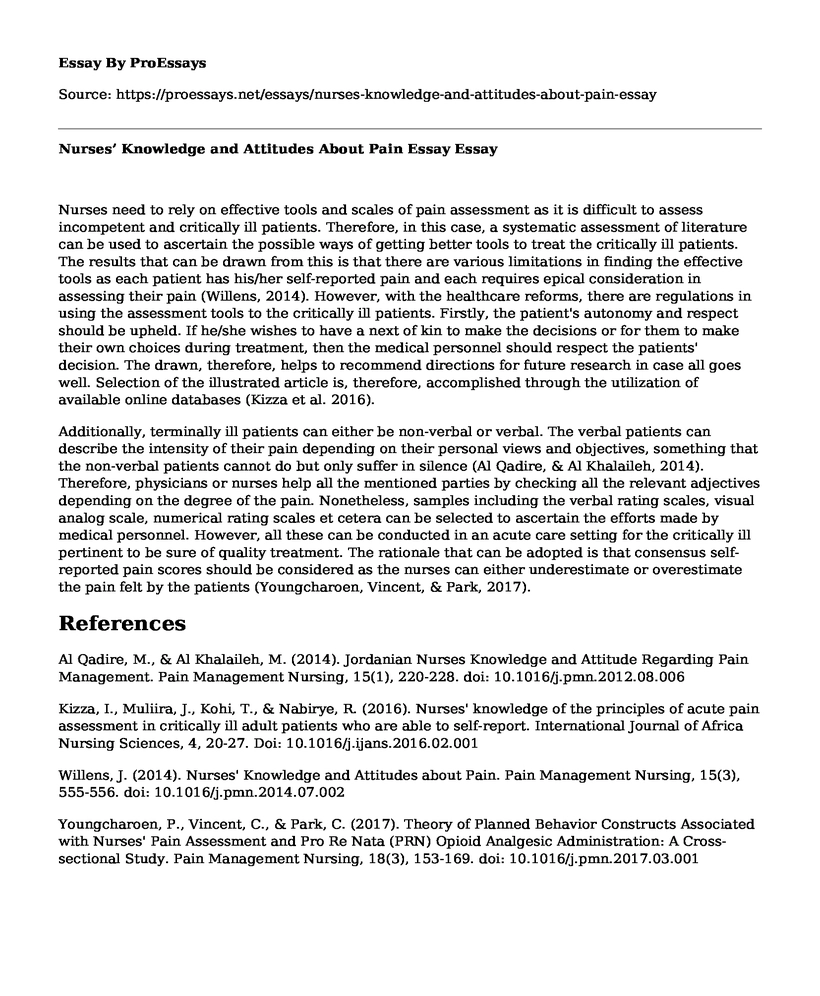Nurses need to rely on effective tools and scales of pain assessment as it is difficult to assess incompetent and critically ill patients. Therefore, in this case, a systematic assessment of literature can be used to ascertain the possible ways of getting better tools to treat the critically ill patients. The results that can be drawn from this is that there are various limitations in finding the effective tools as each patient has his/her self-reported pain and each requires epical consideration in assessing their pain (Willens, 2014). However, with the healthcare reforms, there are regulations in using the assessment tools to the critically ill patients. Firstly, the patient's autonomy and respect should be upheld. If he/she wishes to have a next of kin to make the decisions or for them to make their own choices during treatment, then the medical personnel should respect the patients' decision. The drawn, therefore, helps to recommend directions for future research in case all goes well. Selection of the illustrated article is, therefore, accomplished through the utilization of available online databases (Kizza et al. 2016).
Additionally, terminally ill patients can either be non-verbal or verbal. The verbal patients can describe the intensity of their pain depending on their personal views and objectives, something that the non-verbal patients cannot do but only suffer in silence (Al Qadire, & Al Khalaileh, 2014). Therefore, physicians or nurses help all the mentioned parties by checking all the relevant adjectives depending on the degree of the pain. Nonetheless, samples including the verbal rating scales, visual analog scale, numerical rating scales et cetera can be selected to ascertain the efforts made by medical personnel. However, all these can be conducted in an acute care setting for the critically ill pertinent to be sure of quality treatment. The rationale that can be adopted is that consensus self-reported pain scores should be considered as the nurses can either underestimate or overestimate the pain felt by the patients (Youngcharoen, Vincent, & Park, 2017).
References
Al Qadire, M., & Al Khalaileh, M. (2014). Jordanian Nurses Knowledge and Attitude Regarding Pain Management. Pain Management Nursing, 15(1), 220-228. doi: 10.1016/j.pmn.2012.08.006
Kizza, I., Muliira, J., Kohi, T., & Nabirye, R. (2016). Nurses' knowledge of the principles of acute pain assessment in critically ill adult patients who are able to self-report. International Journal of Africa Nursing Sciences, 4, 20-27. Doi: 10.1016/j.ijans.2016.02.001
Willens, J. (2014). Nurses' Knowledge and Attitudes about Pain. Pain Management Nursing, 15(3), 555-556. doi: 10.1016/j.pmn.2014.07.002
Youngcharoen, P., Vincent, C., & Park, C. (2017). Theory of Planned Behavior Constructs Associated with Nurses' Pain Assessment and Pro Re Nata (PRN) Opioid Analgesic Administration: A Cross-sectional Study. Pain Management Nursing, 18(3), 153-169. doi: 10.1016/j.pmn.2017.03.001
Cite this page
Nurses' Knowledge and Attitudes About Pain Essay. (2022, Jun 19). Retrieved from https://proessays.net/essays/nurses-knowledge-and-attitudes-about-pain-essay
If you are the original author of this essay and no longer wish to have it published on the ProEssays website, please click below to request its removal:
- Coping With Diabetes Essay
- Essay on Health Promotion and Prevention of HIV Infection and Related Illness
- Essay Sample on Community Health Systems
- Cultivating Moral Resilience: My Journey - Essay Sample
- Essay Example on Evaluating Patient Safety Culture in Nephrology Nurse Settings
- Essay Example on Maya's BMI: From Overweight to Obesity & Diabetes Risk
- Essay Example on Depression is a Disease: Aggressive Treatment Needed to Avoid Prolonged Suffering







